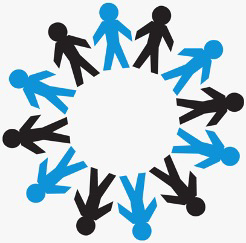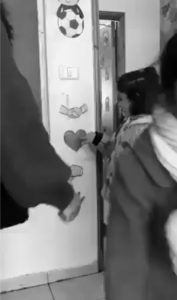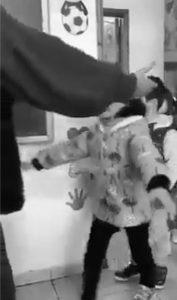- Team Building Overview
- The Why and How
- Many examples
- Video Clips
“The truth of the matter is that about 99 percent of teaching is making the students feel interested in the material. Then the other 1 percent has to do with your methods. And that’s not just true of languages. It’s true of every subject.”
—Noam Chomsky“I will bring you a whole person and you will bring me a whole person and we will have us twice as much of love and everything.”
―“The mind that opens to a new idea never returns to its original size.”
—Albert Einstein
Team Building Overview
Team building exercises build community, develop listening skills and support student engagement. They are a great way of improving communication, morale, motivation, productivity, helping students and educators to get to know each other better, and learning about one’s strengths and weaknesses. Community building is the foundation of a student centered classroom.
Community building exercises have their roots in theater and the stage. In theater, the team must be collaborative with no one ‘dead to the scene’. Drama and street theater can teach and enlighten us thoughtfully with team building. Augusto Boal is the Brazilian dramatist who, during over forty years of work in different parts of the world, has developed the techniques of Theatre of the Oppressed. His successful building of community is a model for a successful classroom. Boal begins with the principle that theatre, like language, can be appropriate to anybody so long as the methods are passed on to them. It is this teaching role that Theatre of the Oppressed sets out to achieve. Through series of exercises, games, techniques and drama forms (of which Forum Theatre is the most commonly used), the aim is to understand social reality, and to then be able to change it (for equality and positive outcomes).
In classrooms drama games, what we call community team building exercises, are used to:
- develop a classroom team
- have students and educators aware of each other
- learn to focus on each other
- learn the social manners and reality of the classroom
- change for the positive the classroom team
- have students become the autonomous leaders of the classroom
The goal is to have everyone involved with the community team building exercises with a focus upon student engagement using the exercises as a foundation for the classroom.
While many community building exercises score high on the fun factor and do create some shared memories, they must also deliver an outcome of a stronger team. It is important to be meaningful and challenging with exercises that often is completely outside our context and comfort zone to really elevate the classroom community as a team of learners both individually and together.
The examples of team building exercises below are an introduction. It is recommended to seek out more exercises in published books, on the Internet and by taking classes locally including with theater and improvisation classes.
Implementing
While the idea of building community is a systems thinking approach of the whole classroom, an important process to building the community is with the exercises and games in this section (or other ones from many sources). Begin with one that you are comfortable with, and then brainstorm and sequence what you need to do, how you will introduce it, and then start doing the exercise.
Practicing
Like everything we do, practice will bring success. I recommend that you practice the same exercise multiple days in a row. I highly recommend videotaping the community exercises in action to watch and learn from the experience.
You’ve got to learn your instrument. Then, you practice, practice, practice. And then, when you finally get up there on the bandstand, forget all that and just wail.
—Charlie Parker“I am deliberate and afraid of nothing.”
—Audre LordeAn ounce of practice is worth more than tons of preaching.
—Mahatma Gandhi
Changing It Up
If we did exactly the same thing the same way all the time, we would become bored. While we do want to practice a particular community exercise multiple times for developing understanding and expertise, it is important to change up what we are doing for interest and success. This can be adding an element to an exercise (e.g. with Zoom adding Eek) and/or combining different exercises together (e.g. Zoom and Moving in Rhythm) after introducing them separately.
Student Centered
As you are regularly doing community building exercises, ask the students to take the lead with exercises you the teacher has introduced. The next step will have a student take the lead on a community exercise they know, have found in a book, have seen on the Internet or have invented on their own (or in collaboration with another person).
Reflection
After doing community building exercises, ask the students what was the purpose of the exercise, what were the steps, and how would you modify and/or change it up. Additionally ask the students where they might use community building exercises in the the school and in other settings.
Community Building Examples on video.
in an elementary school.
Building Community Exercises: Team Building
Learning About Each Other Together
Mingle
The group mingles, casually talking to each other. As they continue mingling, you call out a name of a category, like pets. The players then have to find other people who have that in common with them. Other categories you can try are: someone with the same number of brothers and sisters as you, someone with the same color eyes as you, or someone with one of your hobbies. Let one of the players take your place and be the leader who can call out the categories.
People to People
Everybody mingles around, greeting one another normally (thus the title “People to People”). You, as the leader, stop movement by proclaiming “elbow to elbow!” or “knee to ear!” The group must form whatever configuration you say by finding someone to touch elbows with or a knee to put an ear on. When you say “people to people,” the mingling and greeting begins again. The game becomes more creative when you announce animal configurations, like “Elephant to Elephant!” or “Snake to Snake!” or “Alien to Alien!” These can lead to “Trunk to Trunk!” and “Tail to Tail!”
In Common or Commonalities
Participants face the inside of the circle on their individual spots. One person (start with the lead facilitator modeling several times, then each person will do it once) will state something true about themselves. An example might be “I have taken guitar lessons.” Then everyone who has this “In Common” with the person who stated “I have…” will leave their spots and trade with someone else. This is followed by another person sharing something true about themselves. Then everyone who has this “In Common” with the person who stated “I have…” will leave their spots and trade with someone else.
I Love My Neighbor
Participants face the inside of the circle on their individual spots, except for one person, for example Langston, who is “It” and stands in the middle. Langston starts by saying “I love my neighbor who…,” finishing with a characteristic or description, such as, “I love my neighbor who has an older brother.” Then all the participants to whom this is true leave their spots and trade with someone else. Langston then scrambles for the open spaces, and whoever is left without a seat is the new “It” and must begin again saying “I love my neighbor who…” Each person who is “It” is not allowed to repeat any of the other things previous “Its” have said.
Trust
Participants are in pairs. They will connect with hands (you could also do it with elbows, fingers, etc.). One person will close their eyes and the leader will keep their eyes open. They will then start walking together. It is the responsibility of the leader with the eyes open to lead the other person who is trusting them on a safe path while they are walking around. Initially do for short segments (e.g. 30 seconds), then have the pairs switch who is the leader.
Building Community Exercises: Team Building
Focus and Concentration
Zoom
In a circle students orally pass the word zoom around from one person to another. The exercise moves rapidly to build and sustain community involvement. Extensions include switching directions, multiple zooms at one time, students leading zoom, use of different polygons to form the ‘circle’ (e.g. square), & other words to build vocabulary. Initially introduce with students sitting in a circle. Changing it up: Instead of voice, use a gesture and/or sign language.
Zoom EEK
In a circle students orally pass the word zoom around from one person to another. Introduce the word EEK to everyone—means stop and go the other direction. When the leader says EEK whoever has the zoom changes direction.
Movin’ in Rhythm
Everyone forms a circle. It is helpful to hold hands when first learning Movin’ in Rhythm. When in the circle everyone starts moving clockwise (or counter clockwise) together. The goal is to be moving like a smooth wheel going in a circle. The leader can be at the controls to control the speed of the wheel or turn it on and off.
Movin’ Zoomin’
Everyone forms a circle. Movin’ Zoomin’ combines Zoom and Movin’ in Rhythm together. First have the group Movin’ in Rhythm, then start Zoom. When these are successful, add EEK.
In-Motion
Combines elements of mirroring and zoom that includes movement, sounds and moving in a circle. One person (initially the teacher) does a motion (movement and sound), then everyone repeats the modeled motion. Then another person in the circle does a motion followed by everyone repeating the modeled motion. The order could be determined from a caller who selects the next person or in order around the circle. In the beginning a suggested rule is to keep your feet on the ground and stay where you are standing.
Pass the Rhythm
Everyone stands in a circle. One person begins by modeling a clap (the rhythm), then turns to a person next to them (we’ll say to the left) and they must clap the rhythm together while looking at each other in the eyes. The person who just received the rhythm now turns to their left and does the same action with the person on their left. This continues until the rhythm returns to the person who began the rhythm. Other ideas include Pass the Face and Pass the Object.
Pass the Motion (The Wave)
The group gathers into a circle and sits facing in. To begin, everyone extends their hands to the center of the circle with their palms up. The leader slowly curls their fingers, one by one, from the left to the right (or other direction). Then, the person to their right curls their fingers up in the same manner, and then the next person in the group, and then everyone continues around the circle. The motion should pass smoothly and fluidly. After the wave returns to the leader, you can pass another motion (perhaps uncurl the fingers) and add a sound. Then, you can pass any other motions, like standing up, raising your hands above your head, jumping, or whatever you think of. As leader, you are in control of the energy level.
Building Community Exercises: Team Building
Whole Group Focus
Machine
The objective of the game is to create an abstract machine using people as parts. One person begins by making a simple repetative motion and sound. The leader selects another person to join the machine – this person adds another repetative motion and sound that works in rhythm with the first person. The leader continues to select people who continue making simple motions and sounds that work in rhythm with the machine. The leader (or a person in the group) is at the controls that can turn the machine off and on, or speed the machine up and slow it down. The leader can be specific on what the machine does or makes.
Fruit Basket
The class sits in a circle on chairs. One person stands in the middle. The participants are equally divided between three fruits (e.g. apple, orange, and pineapples). When one fruit is called by the middle person (e.g. apples), all the apples change chairs including the middle person. The person ‘out’ becomes the next caller. If a caller says fruit basket all participants have to change.
Frozen-in-Motion
The leader and participants sit on their chairs. Initially have the participants feel the floor, feel the chair, and feel the space they are in. This can be done with eyes open or closed. The participants are then directed to feel and replicate an emotion (e.g. boredom, surprise, mad, etc.). The leader (teacher or student) then says freeze. Everyone then freezes as a statue. The leader now says ‘we are now in the museum of _____.’ Everyone is then asked to focus on one person who remains a statue. Have the viewers focus on a particular part of the statue person. Elicit vocabulary to describe different body emotions of the statue person. The vocabulary could be recorded to use on a word wall. This is an excellent exercise leading to a tableau for recreating a part(s) of a story to stimulate and generate discussion.
Group Rhythm
Form a circle and stand in a relaxed position. Everyone holds their arms out to the side in such a way that each person’s index finger is touching the next person’s index finger. In this way the whole group is connected fingertip to fingertip. The object of the exercise is for everyone to clap at the same time.
1.
Community building with professional development (1).
2.
Community building with professional development (2).
Building Community Exercises: Team Building
Pantomime Games
Participants mirror each other in silence. This exercise has the participants focusing on each other to mirror the actions of the person modeling the movements. Initially, and periodically the teacher leads the mirroring activity to model effective movements. It is very important to regularly have students lead the mirroring. These exercises are very effective community builders that build collaboration and the ability to focus. They are excellent for transitions.
Group Mirror
One person stands facing everyone in the class. They can stand anywhere in the class. It is important everyone has a clear view of the person leading the movement. All participants should stand clear of any objects or furniture. The order of modeling could be: moving arms; moving arms and hands; moving arms, hands, and fingers; moving arms, hands, fingers, and head; moving arms, hands, fingers, head, and torso; moving arms, hands, fingers, head, torso, and elements of the head (e.g. the eyes). The person who is the mirror leads the participants for approximately 30 seconds, then says freeze, with all the reflectionsnow a stop motion of their movements. Then upon hearing continue they continue the reflection of the mirror. Group mirror is very effective to quickly start with the students participating from wherever they are in the class.
Circle Mirror
The class, including the teacher stand in a circle allowing room for arm movement. The teacher can initially take the lead as the mirror. The person who is the mirror leads the participants for approximately 30 seconds (one student can be the timekeeper), then says freeze, with all the reflections now a stop motion of their movements. The mirror then selects another person to become the new mirror. The reflections now imitate the motions of the new mirror. The reflections now have a full view of the mirror allowing additional motions beyond those listed in Group Mirror including: moving up and down; moving legs and feet; and whole body movement. Circle mirror is excellent as a collaborative community builder with equal focus upon each other. It is very effective when students will be changing their location in the room. The circle could be formed at the location of the next classroom activity.
Duet Mirror
Very similar to exercises and actions in Circle and Group Mirror. The students stand up and face a partner. Everyone, including the teacher (model), pair with someone in the classroom. They select a mirror person in each pair. They then start until they hear the word freeze in approximately thirty seconds (student timekeeper). The reflection now becomes the mirror. If there are an odd number of people in the class, there can be one group of three.
Detective
Conducted similarly to Circle Mirror. One person who is chosen as the detective turns around (or leaves the room). A person is selected to be the mirror without the detective hearing or seeing the selection. The detective is invited back into the circle and/or room, where they will try to determine who the lead mirror is.



